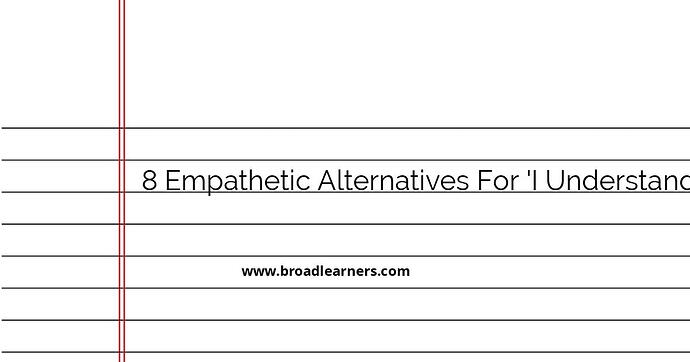In communications, whether personal or professional, expressing empathy is crucial. When someone shares their thoughts, feelings, or situations with you, understanding is just one part of showing support. Using empathetic language can enhance connection and understanding. Let us explore 8 empathetic alternatives to saying 'I Understand' that can convey deeper empathy:
- I hear you.
- I can see why you feel that way.
- That sounds really challenging.
- I'm here for you.
- It makes sense what you're going through.
- I'm with you in this.
- Your feelings are valid.
- It's understandable to feel that way.
Now let's explore each alternative in more detail:
1. I hear you
By saying 'I hear you,' you are acknowledging that you have actively listened to the other person's words. It emphasizes that you are present in the conversation and are engaged with what they are communicating.
Example:
Hi Alex,
I hear you. It must be tough dealing with such a difficult situation. Let me know if there's anything I can do to help.
Best regards,
Emma
2. I can see why you feel that way
This phrase shows that you are empathizing with the other person's emotions. By acknowledging their feelings, you help validate their experiences and show understanding from their perspective.
Example:
Dear Sarah,
I can see why you feel that way. It's a complex scenario, and your concerns are completely understandable.
Best regards,
Michael
3. That sounds really challenging
This expression recognizes the difficulty of the situation that the other person is dealing with. It shows your acknowledgment of their struggles and your empathy for their experience.
Example:
Hi Emily,
That sounds really challenging. I want you to know that I'm here to support you in any way possible.
Best regards,
John
4. I'm here for you
Expressing 'I'm here for you' reassures the other person that they have your support. It's an empathetic way to show that you are willing to be present for them during tough times.
Example:
Dear Tom,
I'm here for you. You don't have to navigate this alone; let me know how I can assist.
Best regards,
Anna
5. It makes sense what you're going through
With this phrase, you are recognizing the logic or reasoning behind the other person's feelings. It shows you are attuned to their situations and can relate to what they are experiencing.
Example:
Hi Jessica,
It makes sense what you're going through. Your situation is by no means easy, and I understand why you feel this way.
Best regards,
David
6. I'm with you in this
By saying 'I'm with you in this,' you are expressing solidarity and unity with the other person. It communicates that you are in their corner as they face their challenges.
Example:
Dear Rachel,
I'm with you in this. We'll navigate these hurdles together. You're not alone.
Best regards,
Sam
7. Your feelings are valid
This statement acknowledges the legitimacy of the other person's emotions. By telling them their feelings are valid, you are affirming and respecting their emotional experience.
Example:
Hi David,
Your feelings are valid. It's okay to feel this way. Let me know how I can help.
Best regards,
Lisa
8. It's understandable to feel that way
When you express that it's understandable to feel a certain way, you communicate that you can empathize with their situation. It shows your willingness to see things from their perspective.
Example:
Dear Robert,
It's understandable to feel that way. You're going through a lot, and I'm here to listen and support.
Best regards,
Jennifer
Using these empathetic alternatives will help you communicate understanding and support more effectively. They enhance your ability to connect with others on a deeper level and strengthen the bonds of communication.
Did I miss anything? Respond below
